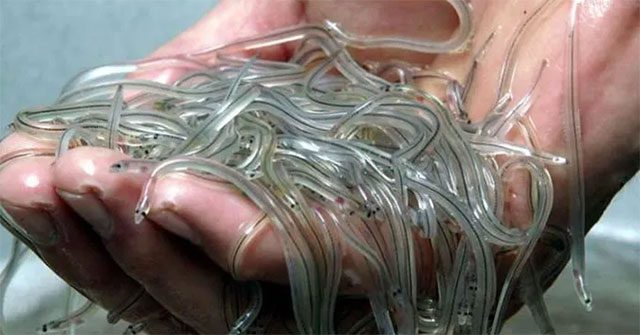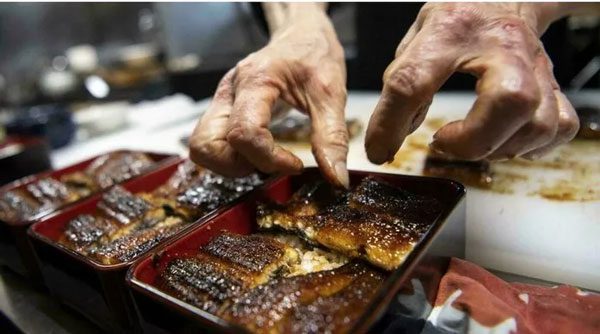The glass eel, with its transparent body resembling glass, is considered a delicacy in many countries. This species of eel is likened to ‘white gold’ and has become a smuggling item that yields huge profits, even surpassing drug trafficking.
Transparent as Glass
The glass eel’s scientific name is Anguilla anguilla, commonly known as the European eel. The name ‘glass eel’ comes from its transparent body color.
The origin of the glass eel species remains a topic of debate. “We believe this species emerged around 60 million years ago near Borneo (the third largest island in the world, under the jurisdiction of three countries: Brunei, Indonesia, and Malaysia…). This eel has adapted as continents drifted, altering ocean currents and increasing the distances between the regions where this species lives and spawns,” said Associate Professor Mari Kuroki from the Aquatic Biology Department at the University of Tokyo, as reported by AFP.

The glass eel has a transparent color. (Photo: EAA).
However, Western scientists believe that this European eel is born somewhere in the North Atlantic Ocean, near Cuba. Subsequently, the juvenile eels were transported from there to other marine areas.
By 2009, scientists had identified the breeding area of the European eel to be west of the Mariana Islands, approximately 2,000-3,000 km from the coast of Japan.
The glass eel is a migratory species with a complex life cycle. To date, we still know little about the reproductive methods of this eel. They are born in the sea and then migrate to brackish and freshwater areas on land, such as river mouths, rivers, streams, ponds, and lakes, to live and grow.
Notably, eels undergo changes in skin color at various stages of maturity.
After hatching, eel eggs develop into larvae. The larvae then transform into glass eels with transparent bodies. Upon reaching maturity, the transparent skin of the eel changes to yellow. During spawning, the eel’s skin turns silver.
Glass eels can live in freshwater for 5-15 years before swimming back to the sea to spawn and die. They only reproduce once in their lifetime.
They can live up to 80 years, reaching a maximum length of 130 cm and weighing 1-2 kg when mature.
Currently, glass eels are on the International Union for Conservation of Nature (IUCN) list of “critically endangered” species that need protection. Their population has severely declined, by up to 99% over the past 30 years.
Smuggling Glass Eels More Profitable than Drug Trafficking
The significant decline in glass eel numbers is also due to illegal trading activities.
Juvenile European eels are placed in suitcases filled with water and oxygen, or transported as illegal seafood shipments from Europe to Asia by air, before being raised in eel farms.

Eel meat is a specialty dish in Asia. (Photo: AFP)
In Europe, a glass eel costs 0.1 Euro, equivalent to nearly 3,000 VND. However, upon arriving in Hong Kong (China), its price is 1 Euro. After one year of farming, the price of the glass eel rises to 10 Euros.
The value of a glass eel increases exponentially along the supply chain. Hence, this species is also referred to as “white gold” due to its sky-high prices.
Glass eels are smuggled from Europe to Asia. The smuggling operations typically target juvenile eels, as at this stage, they have transparent bodies like glass.
To ensure a steady supply, smugglers have begun capturing and farming juvenile glass eels until they mature before selling them. Most of the European eels consumed in Japan currently originate from aquaculture farms, with only a small percentage coming from wild catches. This scarcity has led to a surge in the price of glass eels.
In China and Japan, glass eels are considered a delicacy and are believed to enhance vitality. Glass eels in China sell for 5,500 USD/kg (over 130 million VND). In France, one kilogram of glass eels costs 250 Euros. This is considered the most expensive eel species in the world.
The glass eel smuggling trade has become appealing to many due to its profits, which exceed those from drug, arms, or human trafficking. According to the European Eel Conservation Organization, the glass eel smuggling trade generates about 3.7 billion USD annually.
However, those involved in glass eel smuggling also face significant risks, including imprisonment.
A court in France on October 30, 2019, sentenced two Chinese tourists to prison for smuggling 60 kg of live glass eels hidden in their luggage on a flight to China. The Southwark Criminal Court in London on February 7, 2020, convicted a British citizen of smuggling 200 kg of juvenile eels worth 7.4 million USD from Europe to East Asia.
From 2019 to 2020, 108 glass eel smugglers were arrested by police in 19 EU countries. Authorities also seized nearly 2 tons of glass eels, valued at 6.2 million Euros during this period.





















































